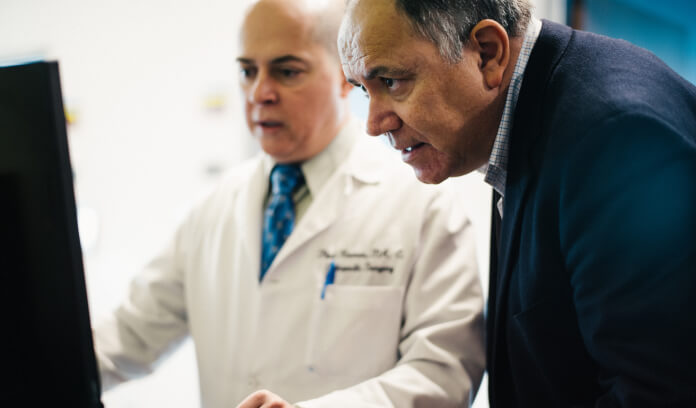How wearable devices are revolutionizing care and remote patient monitoring, and why your HIT needs to keep up
As healthcare evolves towards better connection, data exchange, and interoperability, wearable health devices are gaining traction among both patients and payers for their ability to track and share invaluable medical data.
Health-conscious patients, technology lovers, healthcare professionals, and researchers alike are jumping aboard this trend, with the Smart Wearable Healthcare Devices market projected to reach $54 billion in value by 2031.1
This wearable tech offers innovative methods for patients to stay on top of daily wellness, and for physicians to remotely monitor patients’ health with patient consent to help improve health outcomes and enhance personalized patient care.
Below, we'll take an in-depth look at some of the different types of wearable health technology, how “wearables” can benefit payers, clinicians, and patients alike, and why your HIT software needs to stay interoperable in order to receive, filter, and act on this new source of health data.
What are wearable health devices?
Digital health trackers, commonly referred to as “wearables”, help patients track various elements of their overall health, such as steps taken in a day or week, blood pressure, glucose, heart rate, and sleep analysis. This technology gives patients the ability to collect their own health data and can be transmitted to smartphones or computers for analysis and feedback.
Many payers and employers promote wearable health technology as a way for patients to stay healthier and lower their risk. Some payers even offer rewards programs and other incentives for patients who are using wearables for a healthier lifestyle.2
So, why is wearable tech important for physicians to have on their radar?
To start, it could be a game-changer in collecting patient medical data important for reimbursement in value-based care payment models, and in enabling more accurate risk assessment for patients.3 This tech is also helping drive a growing trend in remote healthcare and telemedicine for both traditional practices and online startups.
If HIT systems can keep up with wearable health devices to collect the right real-time medical data, those relevant patient insights could be critical for physicians.
Examples of wearable health devices
- Blood pressure monitors: These wearables measure blood pressure levels throughout the day, providing long-term tracking and data for managing health conditions like hypertension.
- Glucose monitors: Wearable glucose monitors keep track of blood sugar levels in interstitial fluid in real-time, allowing patients with diabetes to manage their condition effectively. Some Continuous Glucose Monitors (CGMs) can connect with insulin pumps to automatically administer insulin during a glucose spike. Many CGMs today also have a corresponding smartphone app for viewing trends in glucose levels.
- Pain management devices: Using technology like transcutaneous electrical nerve stimulation to provide pain relief and control muscle spasms, wearable pain management devices help patients with chronic pain so they can get back to their daily activities.
- Holter monitors: Portable ECGs (electrocardiograms) like Holter monitors help record the heart's electrical activity, detect irregularities, and can provide insights into overall heart health, including monitoring for atrial fibrillation and atrial flutter. Some ECG monitors can make it easier for cardiologists to diagnose common arrythmias depending on the device’s sensitivity.4
- Pacemakers: A small wearable device that’s implanted under the skin, pacemakers deliver electrical impulses that help maintain a normal heart rate and rhythm.
- Fitness Trackers: Fitness trackers are wearable devices that monitor physical activity and have risen in popularity for health-conscious consumers. Although the ways in which they integrate with HIT are still evolving, they can track valuable information such as steps taken, distance traveled, calories burned, and sleep patterns. They also track heart rate and sometimes include a GPS for location tracking.
- Smart Watches and Rings: Similar to fitness trackers, biosensors in smart watches and rings enable patients to track various health metrics like body temperature, oxygen and hydration levels, heart rate, activity and movement, and sleep analysis. Some models also include ECG capabilities as well.
What clinicians and payers can glean from wearable devices
If HIT systems are able to accept and parse through real-time medical data from wearable health devices, this could be a valuable opportunity for those relevant patient insights to be used in a number of ways: to continually assess risk, stay on top of chronic conditions, and create more personalized patient wellness plans. But interoperability between wearable technology and EHR software is essential in order for this data to meaningfully benefit clinicians.
Wearable health devices can be critical in helping physicians to achieve outcomes like:
Remote patient monitoring: Real-time monitoring can help ensure timely intervention during a serious health event, helping reduce urgent care and hospital visits while improving overall patient well-being. Wearables are also becoming essential tools in senior care, offering useful features like fall detection, medication reminders, and emergency calling to better ensure the safety and independence of aging populations.
Data-driven insights: Physicians can use the valuable data generated by wearable health tech to tailor treatment plans based on individual patient needs and inform overall clinical decision-making. Aggregated health data and trend data over time provides clinicians with important insights for evidence-based practice and research.
Telehealth and telemedicine: Wearable health technology can enhance the telemedicine landscape, enabling remote consultations backed by real-time medical data, fostering patient engagement and improving healthcare accessibility.
Improved patient engagement: By encouraging patients to take an active role in their health management, wearables can foster better, more proactive communication between patients and healthcare providers. This patient-sourced data creates a more collaborative relationship, enabling more personalized care.
Better patient education: Physicians can use data from wearables to educate patients and proactively discuss topics about their health, encouraging lifestyle changes and adherence to treatment plans.
Preventive care: Wearable medical devices can help identify risk factors and promote preventive measures, enabling physicians to address potential health issues before they escalate.
Chronic care management: These devices provide monitoring of chronic medical conditions such as diabetes, hypertension, and heart disease, offering insights that empower patients to take a proactive approach in disease management.
Why interoperability with wearable devices can be beneficial for gaining insights from real-time data
An emerging field, some wearable devices are able to integrate with electronic health records (EHRs) and other health IT systems, facilitating seamless data sharing and improving care coordination. As the technology continues to advance, physicians can incorporate the medical data collected from wearables into wellness visits, using it to inform discussions, identify health trends, and make data-driven decisions. Ensuring that HIT software is compatible and interoperable with wearable health technology can therefore set physicians up for future success if they plan to integrate this patient data into their personalized wellness plans and clinical workflows.
Monitoring wearable technology trends for more holistic patient care
Wearable health devices are influential in steering the healthcare industry towards a more connected and personalized future. By integrating this information into their practice, clinicians can better monitor patient progress, adjust treatment plans, and ultimately improve health outcomes, making wearable health devices a valuable tool in modern healthcare.
As wearables become more advanced with new features, automation, and apps, their ability to provide meaningful health data and enhance patient outcomes will continue to grow. EHR software that uses AI and automation to help analyze and sort relevant medical data will be critical in making sure physicians aren’t overwhelmed with patient data from wearable health devices. Practices should stay informed about where their EHR systems leverage AI and automation for functionality like pattern and anomaly recognition, gaining insights from trends in patient data, and other capabilities.
Wearables are bigger than an individual patient or practice. They have the power to personalize healthcare and empower patients in a way that could influence risk adjustments for value-based care, payer incentives, data connections across the healthcare ecosystem, and more. Understanding this technology and its ability to illuminate patients’ health patterns and wellness needs will ultimately equip physicians to help specialize and improve patient care.
Want to learn more? Discover how one cardiology practice was able to use valuable biometric medical data and remote patient monitoring to deliver best-in-class preventative care for patients. Read the case study.
More data & interoperability resources
Continue exploring
- Verified Market Research. (2024). Smart Wearable Healthcare Devices Market Size and Forecast. Retrieved May 2025, from https://www.verifiedmarketresearch.com/product/smart-wearable-healthcare-devices-market/
- NIH. (2019, December). Willingness to adopt wearable devices with behavioral and economic incentives by health insurance wellness programs: results of a US cross-sectional survey with multiple consumer health vignettes. Retrieved May 2025, from https://pmc.ncbi.nlm.nih.gov/articles/PMC6912942/
- NIH. (2023, September). Benefits and Challenges of Remote Patient Monitoring as Perceived by Healthcare Practitioners: A Systematic Review. Retrieved May 2025, from https://pmc.ncbi.nlm.nih.gov/articles/PMC10730976/
- NIH. (2022, June). The Use of Wearable ECG Devices in the Clinical Setting: a Review. Retrieved May 2025, from https://pmc.ncbi.nlm.nih.gov/articles/PMC9244148/












